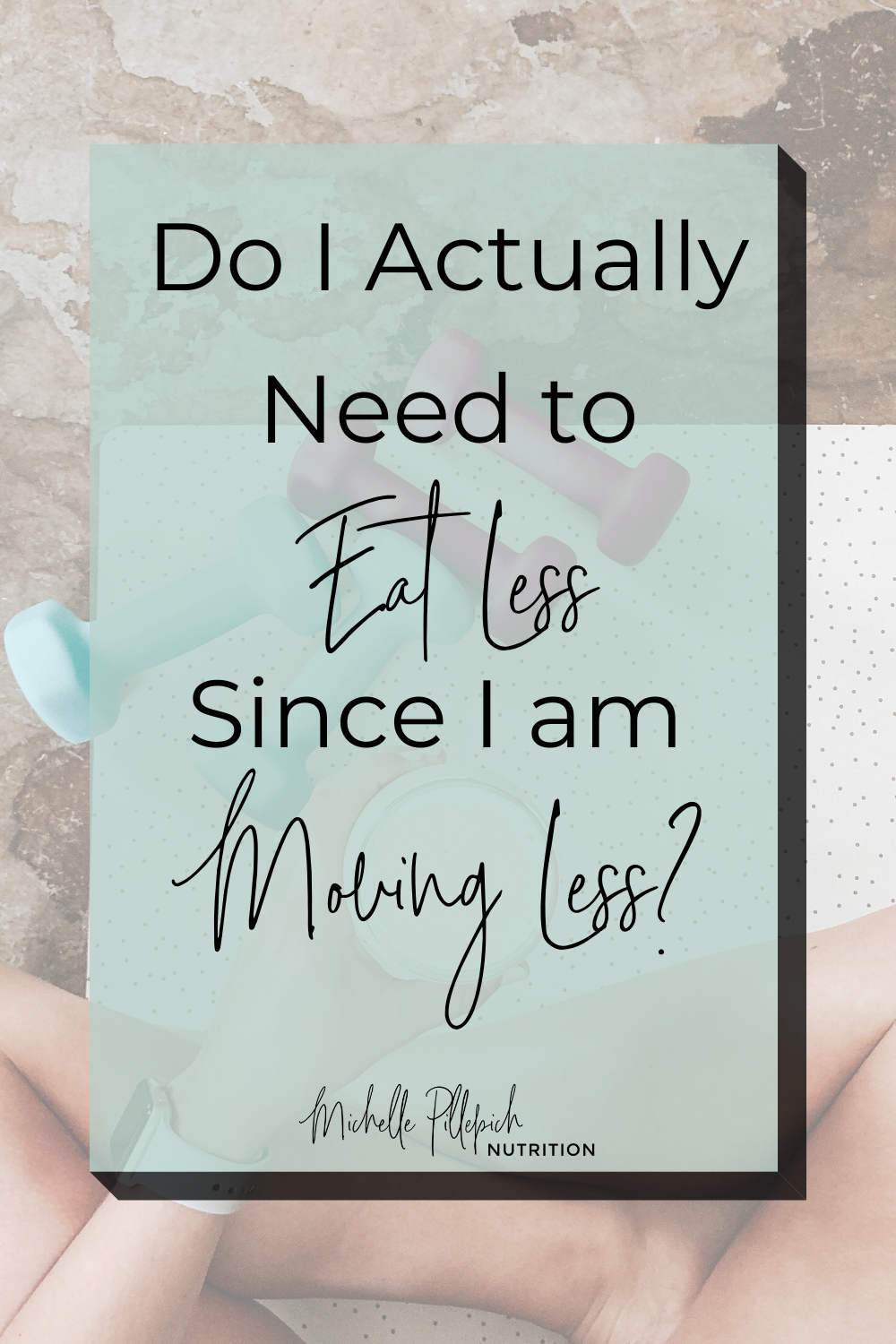
We are about a month into these crazy quarantine times. Everyone is social distancing, staying home (as much as possible), and likely moving around a lot less than we would be during our normal routines. I have been hearing a common and constant concern from clients:
Shouldn’t I be eating less since I am moving less?
Maybe you’ve had the same thought! There are tons of people joking about quarantine weight gain and maybe it has you wondering if you really should be changing your eating pattern. I have been sharing the scientific truth with my clients and wanted to do the same for everyone here. Let’s get into it!

You’ve likely heard about metabolism and all the ways to boost it to burn more energy (and maybe lose some weight!). I hate to break it to you, but lots of those tips are false. The truth about metabolism is that it is mostly way out of our control! The energy we burn is made up of 3 categories:
- RMR
- Physical Activity
- Thermal Effect of Food
Let’s break these down. RMR is your resting metabolic rate. This is the amount of energy that your body is burning just to keep you alive! Your organs burn energy in order to function (your heart to beat, lungs to breathe, liver to detoxify). This component of metabolism is the amount of energy you need to stay alive via functioning organs…to do LESS activity than watching Netflix. Want to hear the best thing about your RMR? This makes up 60-70% of your metabolism! That means that almost ¾ of the food you eat is needed for very basic body functions necessary for survival. None of this has to do with how much you are exercising! Now that we know most of our food is used for basic survival, let’s move on to the portion of metabolism that is made up of physical activity.
Physical activity makes up 15-30% of the energy you burn. Does that mean you should cut down your intake by 30% if you aren’t exercising? Absolutely not! Physical activity is often assumed to mean exercise such as going to the gym, lifting weights, running, or playing sports, but that’s not accurate. This portion of metabolism is made up of ALL the activity we do during the day which includes activities of daily living! If you are standing in the kitchen to cook, moving your arm to brush your teeth (or wash your hands! We’re all doing that a lot more often right now), walking to and from the bathroom to pee, or even just moving your fingers to type, those are all activities that are adding to the amount of energy burned beyond your RMR. Yes, structured exercise is included in this…but it is a much smaller percentage than one might think. Given the fact that with minimal activity, your physical movements make up 15% of metabolism, and the maximum percentage is 30%, the difference between someone with a desk job and a professional athlete is only 15% more metabolic activity! That’s a lot smaller than I would have thought!
The last 10% of metabolic activity is made up of the thermal effect of food. This is, simply, the amount of energy used to power the digestion process. If you are eating, you are also burning energy simultaneously because the intricate processes that go on in our body to break down our food require energy. Add this percent of metabolism to the 60-70% that is from RMR and up to 80% of the energy you burn is coming from absolutely essential activity!
So…what is the point of all this scientific information? My point is to tell you that you do not need to restrict your food intake while you are working from home and leaving the house MUCH less than usual. The energy you take in from food is almost entirely being used to power necessary functions that keep you alive. Even if you sit on your butt and lose all the muscle you have…you still need energy because your ORGANS are much more metabolically active than even your muscle. This means that organs burn the most energy of any part of your body! (organs vs. muscle vs. fat). As long as you are alive and have functioning organs, you need to eat to fuel them. Incorporating movement during this time (if you are able to do so) can definitely provide benefits such as mental clarity, improved digestion, cardiovascular health, and enjoyment! Whether that movement routine is a long run outside or a short yoga video at home, you still need to eat regularly. Even if most days your movement is walking to the mailbox or the fridge, remember that movement is increasing your needs above your RMR. Restricting your intake will actually slow your metabolism and cause your body to preserve energy rather than burn it. Maintaining regular meals and snacks at regular intervals throughout the day will keep your metabolism, blood sugar, energy, and mood all happy – and we can all use a boost of happy – so keep enjoying whatever you’re eating!
*source for metabolism categories and percentages: Mol Metab. 2016 Nov; 5(11): 1057–1071.
I learned a lot of my metabolic knowledge from Marci Evan’s course! I would highly recommend this to all ED dietitians out there.